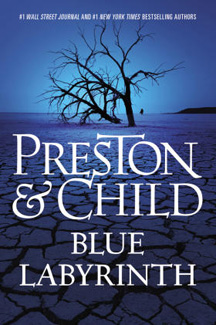For their 14th Pendergast novel, Douglas Preston and Lincoln Child do more than merely pay lip service to the evocative location that put them on the map with “Relic” nearly two decades ago. Margo Green, haunted by the events of “Relic” and “Reliquary” – and even more so, “Dance of Death” — is once again stalked through the bowels of the New York Museum of Natural History in “Blue Labyrinth” (November 2014, hardcover).
I don’t think I’ll ever get tired of scenes of Preston and Child’s protagonists exploring dim, musty rooms filled with rare botanicals, disinterred skeletons and jars of whale eyeballs – even if one action scene of Margo climbing on T-rex and triceratops skeletons is a bit too on-point in this year of “Jurassic World.”
But as is increasingly the case in P&C novels, not all of the action takes place in the museum. The most evocative new setting in “Blue Labyrinth” is a ghost town on the shores of the Salton Sea in southern California. Although the authors take some liberties with the geographical reality of the area, their descriptions nonetheless sent me to the Internet to look up this fascinating inland lake. The Salton Sea was accidentally created when a manmade dam broke in the early 20th century, then it became a hotbed for beachgoers, fishermen and vacationers at midcentury before increasing salt levels led to an economic bust – and not quite full-on ghost towns, but close enough to inspire the abandoned luxury hotel described in the book.
Our favorite FBI agent’s investigations also take him to a harrowing, ungoverned city within the city of Rio de Janeiro. In a classic Pendergast moment, he goes off on a rant against a traffic cop.
“Blue Labyrinth” is the best novel so far for Pendergast’s ward Constance Greene, who – like Nestor Carbonell’s character on “Lost” – never ages. With Pendergast struck ill, Constance joins scientist Margo and NYPD Lieutenant Vincent D’Agosta as a hero of the piece. Another fun place to explore in P&C novels is the bowels of Pendergast’s Riverside Drive mansion, and Constance finds some deliciously grisly weapons in the experimental labs of Enoch Leng to use on her enemies.
Pendergast’s family tree is in danger of becoming comically convoluted, as Alban Pendergast – Aloysius’ bad son, as opposed to the good son Tristram – is in many ways a replacement for Aloysius’ late, unlamented brother Diogenes. But “Blue Labyrinth” does bravely address an issue that the authors could have left untouched without much backlash: For all of Pendergast’s heroism and good deeds, his personal fortune and high standard of living was made possible by his ancestors’ unsavory means of gaining wealth. The villain’s revenge scheme, which dates back through the generations, forces Pendergast to own up to this reality.
For P&C scholars, “Blue Labyrinth” has some juicy tidbits. It reveals that the novels have not taken place in real time; it’s maybe 10 or 15 years since “Relic,” not a full 20 years. And Pendergast accepts a salary of $1 a year from the FBI just to keep things official (I’m not sure how that doesn’t violate federal minimum wage laws, though), and he basically assigns himself to cases and taps into his own wealth to cover expenses. We already kind of knew that, but the authors clarify the situation here.

While the scheme by Pendergast’s opponent is almost hilariously complex, “Blue Labyrinth” works thanks to the settings and character growth. While I doubt P&C intend to kill off Pendergast anytime soon, this novel proves that Constance could work as a main character too.

